I was up and ready to go at 5:00 AM for the trip back over the hill to McCloud. We dropped off the First Section passengers back at their train and our driver took us to the shops where our Second Section had dropped us off, but was not there yet.
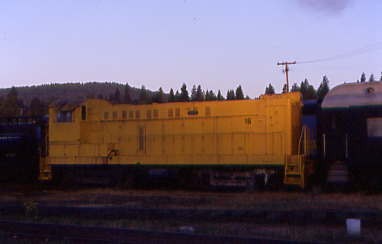
I found McCloud S12 30, ex. Western Pacific Railroad Museum 16, exx. United States Steel 16, exx. United States Steel 76, exxx. United States Steel 16, exxxx. Rayonier Forest Products 203, nee McCloud River Railroad 30 built by Baldwin Locomotive Works in 1953, waiting the sun to rise on another clear morning. I next walked into the McCloud shops.
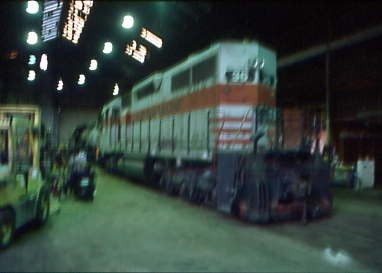
McCloud SD38 36, built by Electro-Motive Division in 1969.
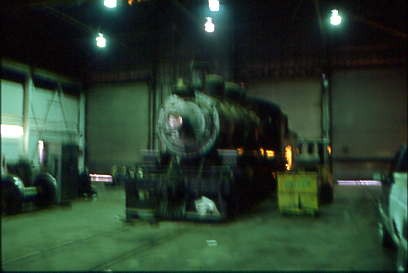
My old friend McCloud 2-8-2 25. The story of what would become one of the more popular excursion steam locomotives in the west started in 1924 when the McCloud River Lumber Company purchased harvesting rights to the 87,000 acre Bear Creek Tract from The Red River Lumber Company. The Bear Creek tract secured the future of the McCloud operations for many years to come and allowed the companies to invest in improving their equipment rosters.
The McCloud River Railroad at the time powered its trains with Mikados 14, 15, 18 and 19; Prairies 4, 8, 9, 10 and 11; Shays 16 and 17; Mogul 12 and 0-6-0T 6. The Bear Creek sale would substantially expand the length of the railroad's log hauls, which in turn brought the smaller size and increasing age of the old Prairies and the painfully slow operating speeds of the Shays into sharp focus. In late 1923 the railroad ordered two large modern Prairies new from Baldwin that became their 20 and 21, which sidelined the Shays after their arrival. The efficiency and versatility of the new Prairies prompted the railroad to start shopping for more such power.
The McCloud River Railroad up to this point had been a loyal Baldwin customer. Baldwin had built fifteen of the nineteen known locomotives the railroad owned through early 1924, twelve of those built new for the road. American Locomotive Company proposed building four new Prairies for the railroad, two about the same size as the 20 and 21 and the other two to a larger size, at a substantially lower cost than the Baldwins. McCloud management accepted the proposal, and Alco built the smaller two Prairies (22 and 23) in July 1925, followed by the larger two (24 and 25) in September.
25 would be the last steam new steam locomotive the McCloud River Railroad bought, and it proved to be a popular locomotive amongst the operating crews. While purchased mostly for the logging railroad operations, the 25 was large enough to be used in mainline service alongside the Mikados as needed. 25 worked thirty years in the McCloud woods, spending most of that time assigned to the camp that existed at White Horse, Widow Valley and then Kinyon. The locomotive hauled its first railfan excursion in 1953 and then in 1955, the railroad gave 25 a spectacular paint job and used it to power the Gold Spike Special to Burney to celebrate the opening of the new line. 25 spent a few more months operating out of Pondosa in the late summer and fall of 1955 before the end of log haul operations finally put steam to bed on the railroad.
Railroad president Flake Willis talked the Board of Directors into keeping 25 around and so the company stored it instead of sending it to scrap with the rest of the steam fleet at the end of 1955. Railfan excursions started returning to the railroad in 1959 and 1960, and in the early 1960's, many railfans and railfan organizations started requesting that the railroad bring 25 back into service. It had been overhauled not long before being stored and proved to need very little work before starting its second career as an excursion engine in 1962. It rapidly became one of the more popular excursion engines on the west coast, and several organizations- most notably Pacific Locomotive Association and the Northern California Railroad Club- frequently sponsored trips over the railroad. Two commercial excursion operators tried regularly scheduled passenger excursions using 25, the Mt. Shasta Alpine Scenic Railroad in 1964 and then the Shasta Huffen Puff starting in 1967.
25's boiler certification was due to expire in late 1970 and the railroad ran a number of "last runs" through that late summer and fall. The success of those runs changed the railroad's mind, and it shopped 25 through that winter. Excursions resumed in 1971, though that year proved to be the last for the Shasta Huffen Puff operation. The other excursion operating organizations stepped up their trips in the following years. However, declining patronage and soaring fuel and insurance costs effectively ended excursions by 1975. In that summer the railroad leased the steam engine to MGM Studios, who shipped it and a crew to the Tidewater Southern Railroad to be used in filming the movie "Bound for Glory", a biography film of the fold singer Woody Guthrie. The railroad placed 25 back into storage upon its arrival back in McCloud.
Itel purchased the McCloud River in 1977 and installed Bill Herndon as president. Itel was not interested in owning a steam locomotive, and it ordered Mr. Herndon to sell or scrap the 25 as soon as possible. Mr. Herndon balked at the order and negotiated back and forth with Itel, eventually receiving permission to put the locomotive on public display in McCloud. However, before these plans could be brought to fruition, the Great Western Railroad Museum approached the railroad with a proposal to lease and operate the 25. Itel was willing, and the museum returned it to service in the late spring 1982. The railroad included efforts aimed at promoting possible movie or television location work in its marketing efforts, which paid off in a big way when Columbia Pictures used the railroad and 25 in "Stand By Me" in 1985. The excursions continued into 1986, but by that point relationships between the Great Western museum and the railroad had soured, and the museum filed a breach of contract lawsuit against the railroad. Itel directed the railroad to settle the lawsuit, in which the museum gained title to the 25 and several other pieces of equipment.
25 remained stored in McCloud into the middle 1990's. The McCloud Railway decided it wanted the 25 back and opened negotiations with the museum in late 1995. By this point the museum had not paid storage fees on any of its equipment stored in McCloud for a long period of time, and the railroad struck a deal in which it forgave most of that debt in exchange for the steam engine. Restoration work commenced immediately, and the railroad had the 25 operational again by Labour Day weekend 1997. 25 operated sporadically on the McCloud Railway from then until February 2001, when the railroad stored it again after 18 returned to service.
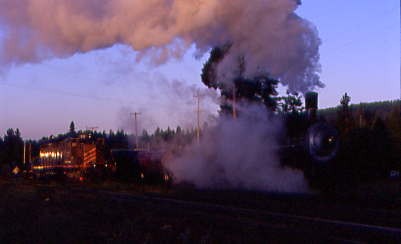
McCloud 2-8-0 18 steaming in front of McCloud SD 38.
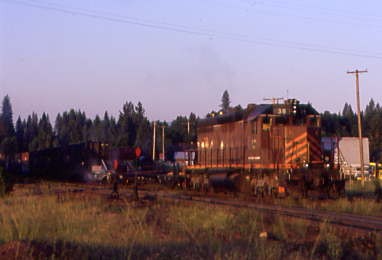
McCloud SD38 built by Electro-Motive Division in 1969.
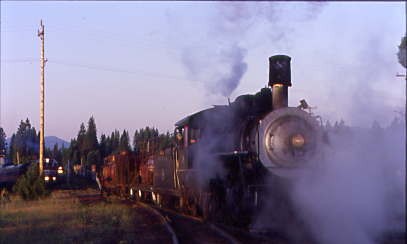
Preparig for the first photo runby of the morning with a short freight was McCloud McCloud Railroad 2-8-2 18, ex. Sierra/McCloud 18, exx. McCloud 18, exxx. Yreka Western 18, nee McCloud 18 built by Baldwin in 1914. Before going into service, it joined a display at the 1915 Panama-Pacific Exposition in San Francisco celebrating completion of the Panama Canal. McCloud River, the Weed Lumber Company and the Red River Lumber Company jointly sponsored the display, the centrepiece of which was a house built entirely of products from the three companies' sawmills. The consist comprised two flatcars loaded with the finest specimens of Ponderosa Pine the McCloud Company could find, a boxcar loaded with lumber from the mill, and caboose 15. After the exposition, 18 returned to haul freight on the McCloud River Railroad.
The MCRR was chartered in 1897 as a common carrier connecting Mount Shasta and McCloud, California. It owned all the rails used by the lumber company and leased most of the motive power, all the log cars and most of the service cars. It also ran passenger services until 1952. Steam power ended on the McCloud River Railroad in 1956 and that year, after forty-one years service on the railroad, 18 was sold to the Yreka Western, a northern California tourist operation. After eight years in service on the Yreka Western, in 1964, the locomotive blew a cylinder head hauling a special excursion. It then went into storage at Yreka until bought by the new McCloud Railway Company in 1998. Restored to operating condition, 18 hauled its first excursion on its home rails on 18th February 2001, doubleheading with McCloud River 25.
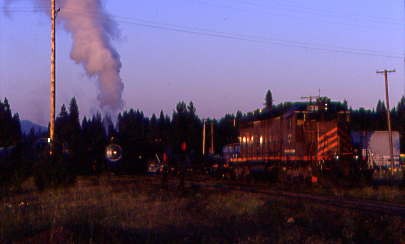
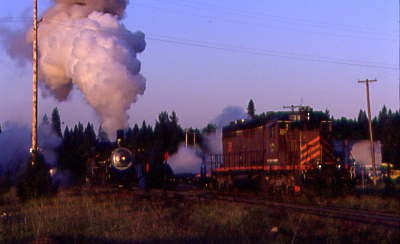
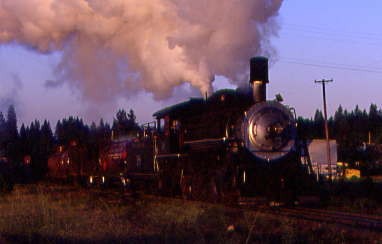
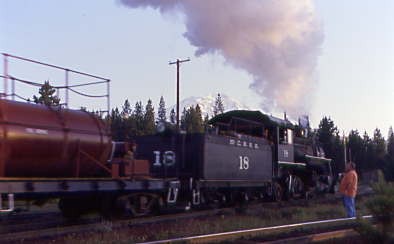
Photo runby one.
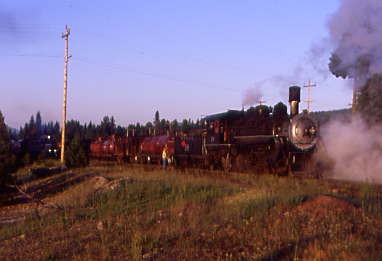
The reverse move. It would come forward when everyone was ready and in postion. There were very few photopraphers here, making some of us think that maybe the people on the First Section were not aware this was taking place.

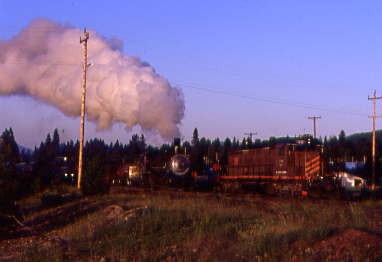
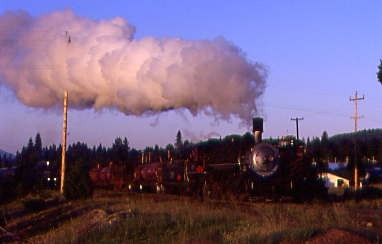

Photo runby two.
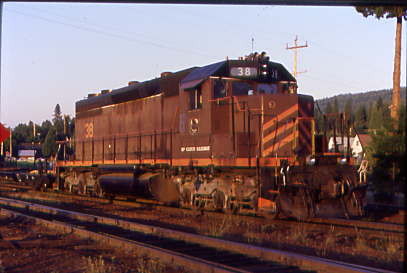
A sunlit picture of McCloud SD38 38 between runbys.
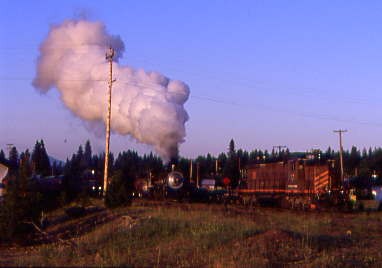
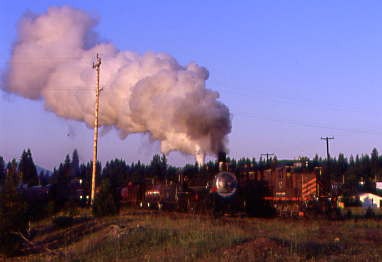
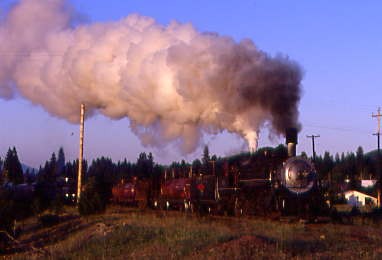
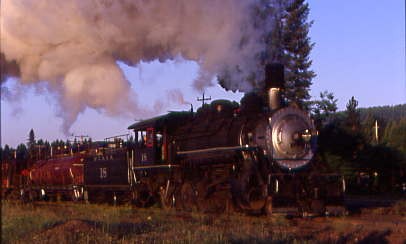
Photo runby three, the final one. I was glad to be part of this and it made up for the whole Signal Butte problem on the Second Section yesterday. We bid goodbyes to McCloud 18, which put on a fine show and reboarded our Second Section of the Trains Unlimited Special and once everyone was onboard, our section departed McCloud for a grade crossing in Mount Shasta City.

Alex Ramos' last picture was taken on Sunday morning of the first section departing McCloud. A special thank you to Alex for the use of his outstanding views of our Trains Unlimited Special.
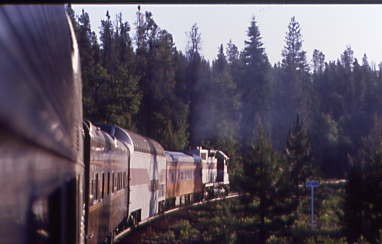
McCloud 37 had no problem in pulling our Second Section up to the Signal Butte switchback.
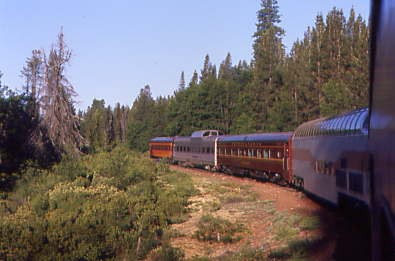
We then reversed down to the grade crossing in Mount Shasta City and great conversations were had with my now happy Second Section early risers. The word to describe the show McCloud 18 put on for us was "fantastic!" At the grade crossing, I detrained through the crowd trying to get back on our section of the train.
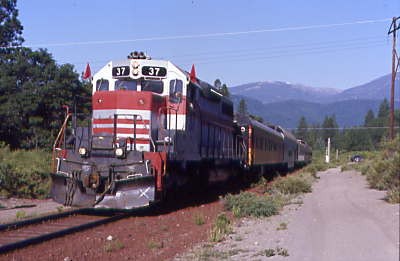
I put my backpack on the chase bus and returned outside to photograph our Second Section, which departed down the Union Pacific interchange and we waited for the First Section to arrive. The time between allowed me time to visit with some of other passenger.
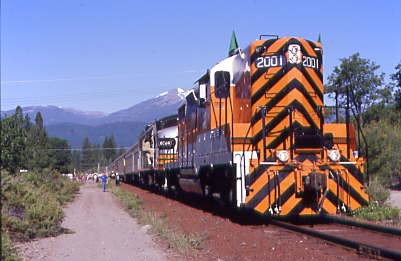
We heard a horn and here came the First Section with people boarding here entrained and a few for the chase bus detarined.

At Mount Shasta was Western Pacific GP20 2001, built by Electro-Motive Division in 1959 and donated by Union Pacific to the Western Pacific Railway Museum in 1985.
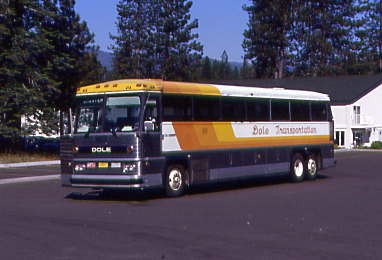
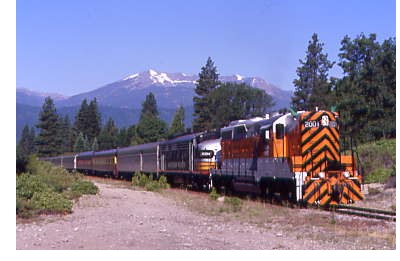
We made a photo line at the grade crossing to catch the First Section reversing to the Union Pacific interchange then quickly boarded the bus and were driven to the interchange, arriving before the train.
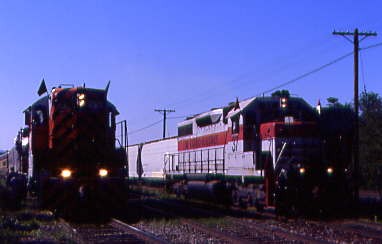
Here are the two sections' power of the Trains Unlimited Special sitting side-by-side at the Union Pacific/McCloud River Railroad interchange.
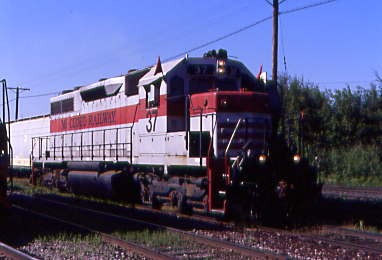
One last look at McCloud SD38 37.
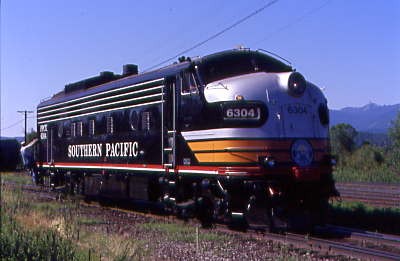
Southern Pacific F9A 6304. We then reboarded the chase bus and drove to Black Butte, where a stop was made at a convenience store for snacks and drinks for the ride to Klamath Falls. We proceeded to the Black Butte grade crossing for our first photograph of the special train and since it was already getting warm, we all took refuge in the shade of the Black Butte water tower.


Our group heard an Amtrak horn and sure enough, here came the Coast Starlight running over four hours late. We returned to waiting and heard over the scanner that Southern Pacific 6304 was having brake valve problems and would be removed from our train. This was not happy news to us and I finally said, "Think of it as a rainbow-era Amtrak train with those engines being prototypes built in 1971, but would not be mass-produced for twenty-five more years. Do not forget what is on the rear of the train." That made for a few laughs as we heard a horn from the other way.
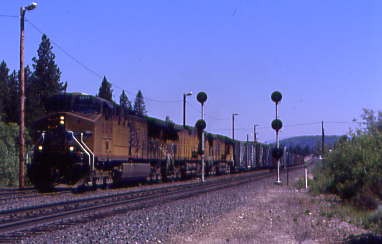
Union Pacific 5809 West ran down the Black Butte siding.
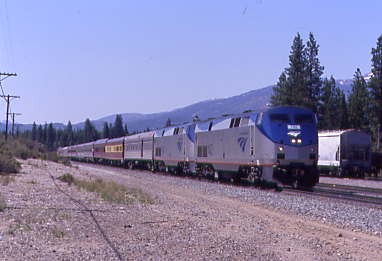
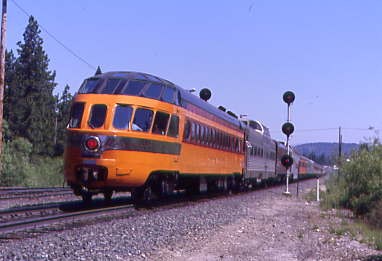

Another Amtrak horn and around the corner came our Trains Unlimited Special running at track speed. We returned to the bus and the chase was on. Driving down US Highway 97, we spotted the train as it was making its way to the Hotlum Trestle. Our bus passengers were trying to get a picture of our train crossing it, but the topography along the highway would not allow it. We made our way, passing Grass Lake Summit, to our next photo location and a Union Pacific freight stopped to wait at Grass Lake.
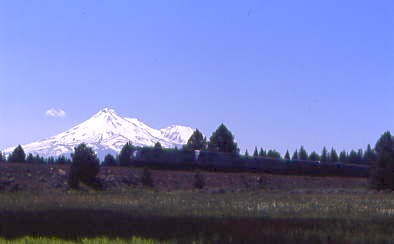
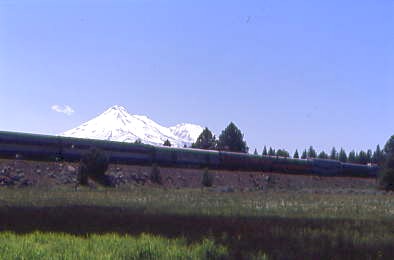
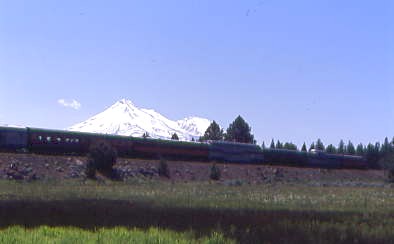
The Trains Unlimited Special on a fill with Mount Shasta standing guard behind. We reboarded the bus and passed the train at Cougar and while the train took the long way through Bray and Kegg, we went the short highway route to Mount Hebron, where we looked at photo locations but did not like any, so moved north. Our next stop was at the Oregon border, but Chris Skow did not like this location so we moved to a grade crossing just before Worden.
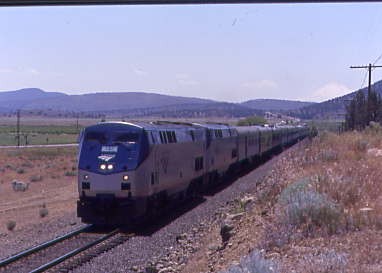
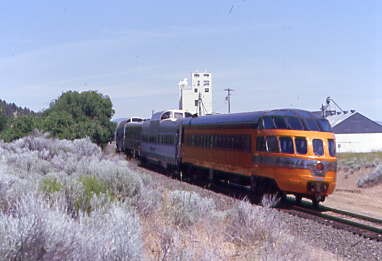
Here I climbed a hill across the tracks that gave me a view with Mount Shasta. It did not take long for our Trains Unlimited Special to arrive, and at track speed he was gone and out of sight in just a minute. We reboarded the bus to go to Klamath Falls and I was glad I had chosen the bus as I was finally able to photograph from the ground on the Shasta Route. Coming into Klamath Falls, we passed Southern Pacific 2-8-0 2579, built by Baldwin in 1906, on display in Veterans Park. The chase bus arrived at the Amtrak station seconds before the special arrived.
Back Aboard The TrainThose who had been on the chase bus boarded the train and I returned to my table in the "Wisconsin Valley" before going to the "Pony Express" for our trip north to Eugene. We departed Klamath Falls at 2:00 PM and once we passed Wocus, started our journey along Upper Klamath Lake.
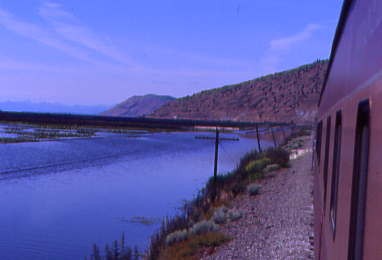

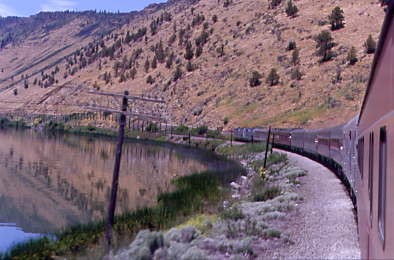
Running along the shore of Upper Klamath Lake is always a beautiful sight from any train. We then sped north through Chiloquin and later Kirk.
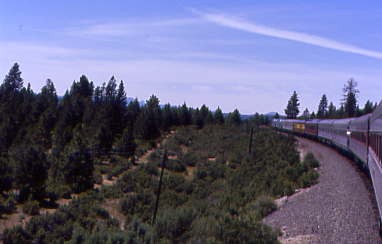
Our train at speed north of Fuego.
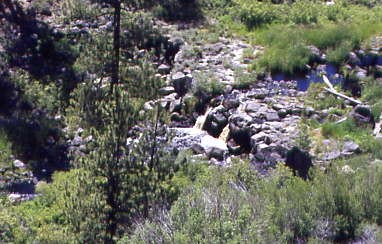
Root Beer Falls, another favourite scene, was running as low as I had ever seen it. We continued to Chemult, where the BNSF Inside Gateway takes off from the Shasta Route then started our westward climb, with no problems, up the grade to the tunnel at Cascade Summit as we passed through Gilchrist Junction, Mowich and Crecent Lake.
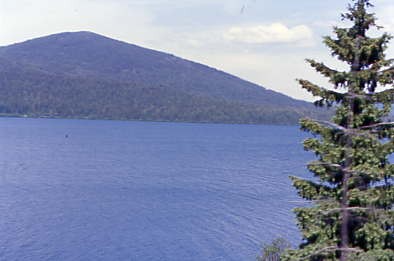
Odell Lake as we neared Cascade Summit.
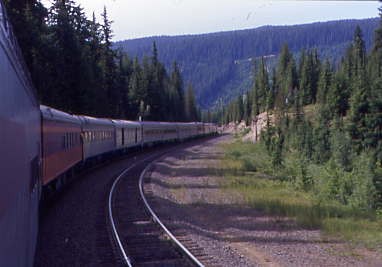
At Cascade Summit siding, we are almost finished the climb to the summit tunnel and went through the tunnel to start the incredible descent down the steep west side grade. The train passed Abernethy before the real fun began with all the tunnels, snowsheds and bridges.
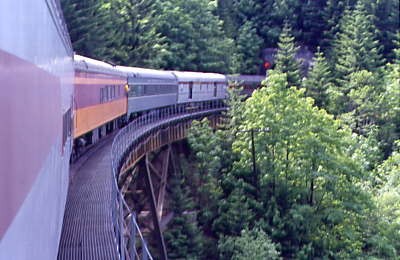
A few minutes later, we crossed Noisy Creek.
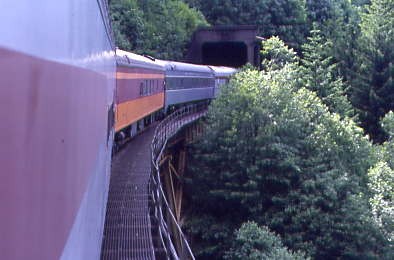
A tunnel, then another bridge, followed by more tunnels and snowsheds.
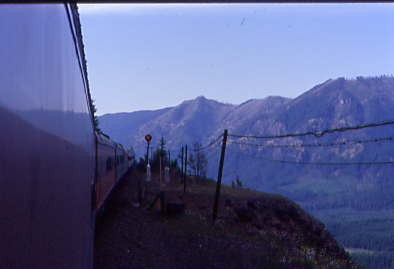
The great vista point, or the falling off the edge of the world, as we continued our descent.
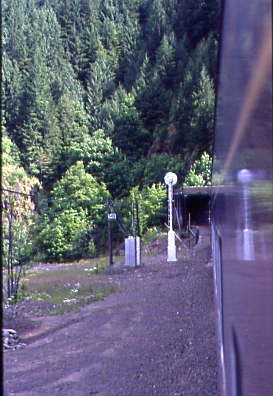
We entered yet another tunnel as we neared Fields.
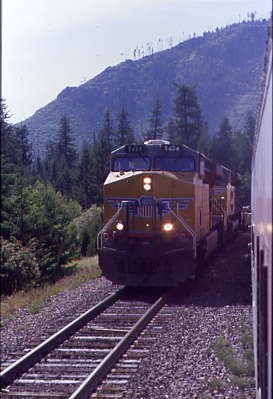
At Fields, we met Union Pacific 5424 West before entering a 180 degree tunnel that would reverse our diection so we would proceed east down the middle level through tunnels to Wicopee. It would take another tunnel before we could reverse our direction again.
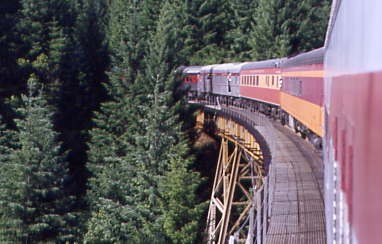
Crossing the Salt Creek bridge to return to a westward heading as we travelled through Heather and McCredie Springs.
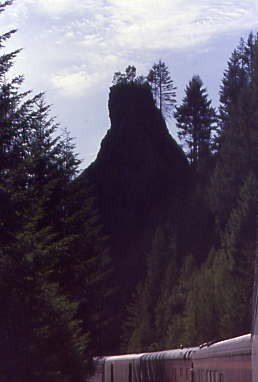
We came out of a tunnel and there was Rooster Rock. The descent continued through Proyer and on into Oakridge, where we stopped for an Amtrak crew change. Once that was completed, we continued on our way through a tunnel and across a creek.
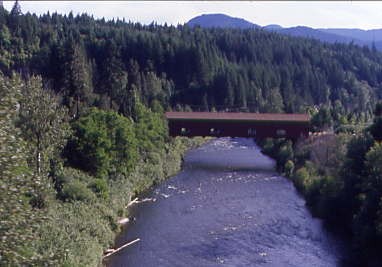
That then put the Office covered bridge at Westfir into view as we rolled down grade to the west.
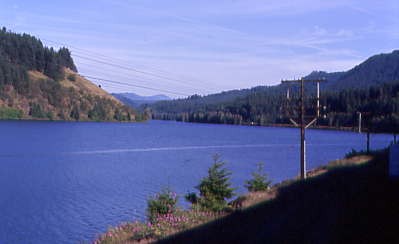
I had never seen Lookout Reservoir this full in any of my travels. About fifty minutes later, we pulled into a siding in Springfield to let Amtrak's southbound Coast Starlight pass about two hours late. The Union Pacific track work window north of Eugene had not been opened until 5:30 PM; this wa the sole cause of its delay.
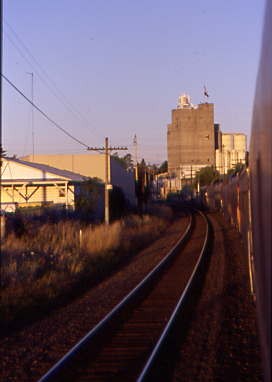
We finally approached Eugene where boxed dinners would be brought onboard. After an extened stay, we finally departed with very little light left in our day at 8:27 PM and ran to the switch of the Central Oregon and Pacific Railroad and stopped before we entered their trackage, which started Chris Parker's and my first new mileage.
Coos Bay Branch Brief HistoryThe Willamette Pacific, with Southern Pacific backing, was built starting at Eugene to Transfer, getting to there on September 13th, 1913. Another company, the Terminal Railway, had built 1.6 miles of track in Marshfield, later known as Coos Bay in 1913 before being sold to the Willamette Pacific. The tracks were built west from Transfer to Walton on April 16th, 1914; to Nekema on September 20th, 1914; and to Mapleton on November 1st, 1914. On July 1st, 1915 the Willamette Pacific was officially sold to the Southern Pacific.
On August 1st, 1915, the line was opened to Cushmen and by April 5th, 1916, the track reached Gardiner. Meanwhile, the line from Marshfield to Reedsport opened on April 5th, 1916. There was now only a 1.6 mile gap between the two ends of the line and that was due to the Umpqua River crossing. Ferry service was provided across the river until the Unpqua River Bridge was completed in early August 1916. The first through train rolled from Eugene to Marshfield on August 24th, 1916. With the line completed, passenger service took off but the Depression cut it back to one train a day, nicknamed the Owl for its overnight schedule. In 1953, the Owl made its final run and the railroad was then all freight until the end of Southern Pacific ownership.
Southern Pacific sold the line to Rail Tex on December 31, 1994 and named it Central Oregon & Pacific Railroad, Inc. then in 2002, RailAmerica acquired control of the Central Oregon & Pacific Railroad. Traffic for this railroad is primarily forest products, chemicals, steel and liquified petroleum gas.
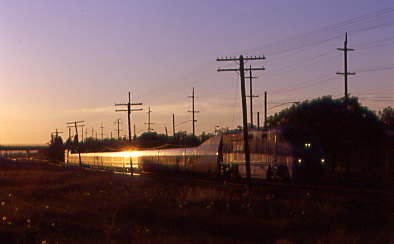
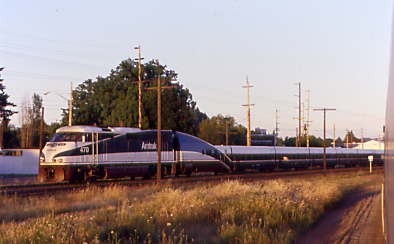
Amtrak Cascades 507 passed us on its way to its final station stop of Eugene. Our crew threw another switch and we proceeded west at yard speed, crossing the former Oregon Electric and out of Eugene. At a lumber mill, we left Union Pacific-controlled track and our speed increased as the sun set and we continued towards the Coast Range in twilight. It became too dark for pictures, so Bart Jennings and I enjoyed the large open doors of the "Pony Express" and rolled across a pair of curved trestles and through the Summit Tunnel 4 of the Coast Range. Bart recorded the mileage and time we passed each milepost and from that, calculated our speed. I just enjoyed the ride in the fresh air and the conversations with my other passengers, as well as Stan Garner, the car's owner.
We twisted and turned as we rolled along Wildcat Creek, which we followed to the junction of the Siuslaw River. Lights from towns such as Richardson, Rainrock and Mapleton were passed during this night-time journey. I returned to the "Wisconsin Valley" to rest and collect my belongings for my night's stay in Reedsport. Later, I returned to the "Pony Express" as we approached Beck. Within a mile, thanks to Bart's great information, I returned to get my luggage and prepared to detrain at Beck, arriving there at 12:15 AM on July 4th.
I have detrained from hundreds of trains all over North America, but never in complete darkness. It was a case of not even knowing what I was walking on. I made my way forward along the train towards some light that were the buses to take us to our hotels. My ticket had my hotel number on it, so I had to find the bus with that number. The first bus was one off and the next was not even close. After visiting every other bus, of course the last bus I found was mine. After pick-up times where announced, we were driven forty-five minutes south to the Anchor Bay Inn in the town of Reedsport. I was second in line and told to find my name on the list. Mine, as well as four other people's names, were not on the list and the owner said he had no more rooms.
I returned to the bus and my driver told me she knew a place in Coos Bay. We were leaving when Chris Parker came out to the bus and told me his roommate was not here and I could share his room. There were six other no-shows, so everyone did have a room at the Anchor Bay Inn. Chris and I called it a night once we entered the room. We were the lucky ones!
Meanwhile, back at the Best Western in Florence, the bus arrived and the passengers went in to get their rooms but since they were so late, the Best Western had given all their rooms away. Bob Riskie had booked on his own and guaranteed it with a credit card, but thought that as was with the Trains Unlimited Trip, they cancelled his as well. Those passengers reboarded the bus and were taken back to the train at 3:00 AM. With no sleeping car rooms available, they all went into the coach to sleep the rest of the night. Since Bob was an Amtrak conductor, he knew these seats could be turned and did just that, and soon everyone was turning the seats. Passengers were given pillows and blankets for their night's stay on the train. In the morning, they we told to get on a bus and go to Florence but all elected to stay on the train. Later, the train was taken to Mapleton to be watered and they all went to lunch. That afternoon, they would all be on our train at our next photo event.